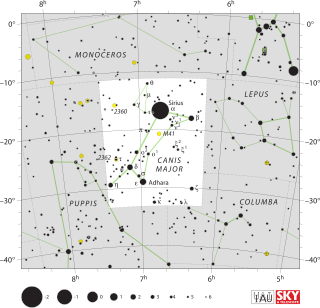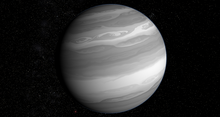
Canis Major is a constellation in the southern celestial hemisphere. In the second century, it was included in Ptolemy's 48 constellations, and is counted among the 88 modern constellations. Its name is Latin for "greater dog" in contrast to Canis Minor, the "lesser dog"; both figures are commonly represented as following the constellation of Orion the hunter through the sky. The Milky Way passes through Canis Major and several open clusters lie within its borders, most notably M41.
HD 11506 is a star in the equatorial constellation of Cetus. It has a yellow hue and can be viewed with a small telescope but is too faint to be visible to the naked eye, having an apparent visual magnitude of 7.51. The distance to this object is 167 light years based on parallax, but it is drifting closer to the Sun with a radial velocity of −7 km/s. It has an absolute magnitude of 3.94.
HD 181433 is a star located approximately 87 light-years away in the constellation of Pavo. According to SIMBAD, it has a stellar classification of K3III-IV, which puts it on the borderline between being a red giant and a subgiant. This is inconsistent with the fact that its luminosity is only 0.308 times that of the Sun. Its entry in the Hipparcos catalogue lists a spectral type of K5V, classifying it as a dwarf star. As of 2008, three extrasolar planets are thought to be orbiting the star. There is currently little information on these planets. The name of this star comes from its identifier in the Henry Draper catalogue.
HD 47186 is a star located approximately 129 light-years away in the constellation of Canis Major. It is a G6V star with the characteristics very similar to the Sun, but it is 1.7 times more metal-rich. In 2008, two extrasolar planets were discovered orbiting the star.
HD 181433 b is an extrasolar planet located approximately 87 light years away in the constellation of Pavo, orbiting the star HD 181433. This planet has mass at least 7.56 times that of Earth. This planet is classified as a super-Earth and orbits at 0.080 AU and varies only about 0.063 AU with an eccentricity of 0.396. François Bouchy et al. have published a paper detailing the HD 181433 planetary system in Astronomy and Astrophysics.
HD 181433 c is an extrasolar planet located approximately 87 light years away in the constellation of Pavo, orbiting the star HD 181433. This planet is at least 0.64 times as massive as Jupiter and takes 962 days to orbit the star at an orbital distance of 1.76 AU, or 263 Gm. The orbit is eccentric, however, and ranges from 1.27 AU at periastron to 2.25 AU at apastron. François Bouchy et al. have published a paper detailing the HD 181433 planetary system in Astronomy and Astrophysics.
HD 60532 c is an extrasolar planet located approximately 84 light-years away in the constellation of Puppis, orbiting the star HD 60532. This planet has a true mass of 7.46 times more than Jupiter, orbits at 1.58 AU, and takes 607 days to revolve in an eccentric orbit. This planet was discovered on September 22, 2008 in La Silla Observatory using the HARPS spectrograph. On this same day, the second planet in this system, HD 60532 b, was discovered in a 3:1 orbital resonance.
BD-17°63 b is an extrasolar planet located approximately 112.5 light-years away in the constellation of Cetus, orbiting the 10th magnitude K-type main sequence star BD-17°63. This planet has a minimum mass of 5.1 MJ and orbits at a distance of 1.34 astronomical units from the star. The distance ranges from 0.62 AU to 2.06 AU, corresponding to the eccentricity of 0.54. One revolution takes about 656 days.
HD 145377 b is an extrasolar planet located approximately 180 light-years awayThis planet was discovered on October 26, 2008 by Moutou et al. using the HARPS spectrograph on ESO's 3.6 meter telescope installed at La Silla Observatory in Atacama desert, Chile.
HD 153950 b is an extrasolar planet located approximately 162 light-years awayThis planet was discovered on October 26, 2008 by Moutou et al. using the HARPS spectrograph on ESO's 3.6 meter telescope installed at La Silla Observatory in Atacama desert, Chile.
HD 73267 b is an extrasolar planet located approximately 177 light-years away. This planet was discovered on October 26, 2008 by Moutou et al. using the HARPS spectrograph on ESO's 3.6 meter telescope installed at La Silla Observatory in Atacama desert, Chile.
HD 20868 b is an extrasolar planet located approximately 156 light-years away in the constellation of Fornax, orbiting the 10th magnitude K-type subgiant star HD 20868. This planet has a minimum mass of 1.99 times more than Jupiter and orbits at a distance of 0.947 AU. This planet takes 380.85 days or 12.5 months to revolve around the star with an eccentricity of 0.75, one of the most eccentric of any known extrasolar planets. At periastron, the distance is 0.237 AU and at apastron, the distance is 1.66 AU.
HD 181433 d is an extrasolar planet located approximately 87 light years away in the constellation of Pavo, orbiting the star HD 181433. This planet has a minimum mass of 0.54 Jupiter mass and takes 2172 days to orbit the star. The average orbital distance is 3.00 AU. At periastron distance, it will have distance from the star similar to Mars’ distance from the Sun at 1.56 AU. At apastron, the distance is 4.44 AU. These corresponds to the orbital eccentricity of 0.48.
HD 45364 is a star in the southern constellation of Canis Major. It is too faint to be visible to the naked eye, having an apparent visual magnitude of 8.08. The distance to this system is 112 light years based on parallax. It is drifting further away from the Sun with a radial velocity of +16.4 km/s, having come within 49 light-years some 1.5 million years ago.

HD 45364 c is an extrasolar planet located approximately 107 light years away.
HD 11506 c is an extrasolar planet located approximately 167 light years away in the constellation of Cetus, orbiting the 8th magnitude G-type main sequence star HD 11506. It is the second planet in this system and its discovery was first claimed in 2009 by using Bayesian analysis on data previously collected by the N2K Consortium. However, in 2015 additional radial velocity measurements showed that the planetary parameters were significantly different from those determined by Bayesian analysis.
HD 20868 is a star in the southern constellation Fornax. With an apparent visual magnitude of 9.92, it is much too dim to be visible to the naked eye. Parallax measurements give a distance estimate of 156 light years from the Sun. It is drifting further away with a radial velocity of +46.2 km/s, having come to within about 124 ly around 312,000 years ago.
HD 73267 is a star in the southern constellation Pyxis, near the western constellation border with Puppis. It has an apparent visual magnitude of 8.889 and can be viewed with a small telescope. The distance to HD 73267 is 165 light years based on parallax, and it is drifting further away with a radial velocity of +51.8 km/s. It has an absolute magnitude of 5.24.
BD−17 63 is a low-mass K type star in the southern constellation Cetus. It is a 9th magnitude star at a distance of about 112 light years from Earth.
HD 145377 is a star in the southern constellation Scorpius. It has an apparent visual magnitude of 8.10 and can be viewed with a small telescope. The star is located at a distance of 175 light years from the Sun based on parallax, and it is drifting further away with a radial velocity of +11.6. The absolute magnitude of this star is 4.31, indicating it would be visible to the naked eye if it were at a distance of 10 parsecs.


